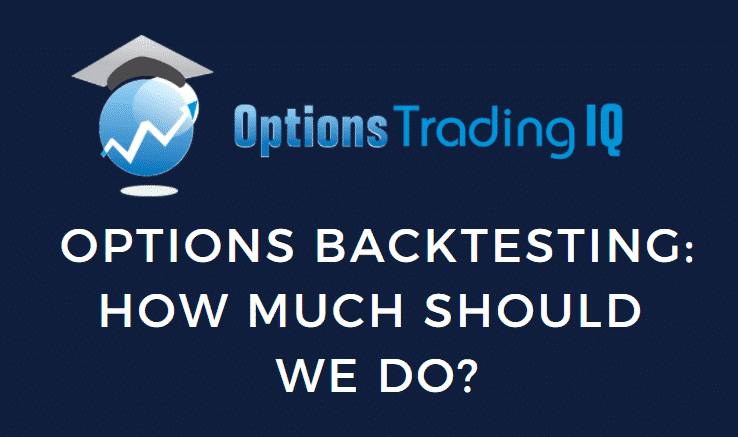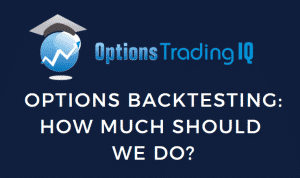

A trader should manually backtest a strategy before trading a new strategy live with real money. But how much options backtesting is enough.
That will depend on the individual comfort level and experience.
But to give you a general idea, we’ve pulled together a series of YouTube clips from reputable traders.
The answer might surprise you.
You need not go through the entire video.
We’ve constructed the link to take you directly to the timestamp. Let’s take a listen.
Contents
- Options Backtesting
- Options Backtesting Lets You Turn Back The Clock
- Speed Up Your Development
- Learn From Option Backtesting
- Necessary But Not Sufficient
Options Backtesting
In this video, Tim Pierson says.
“I don’t trade any new strategy without doing a lot of backtesting and a lot of what-ifs in up markets and down markets.
In my backtesting, I’ve learned some things about this trade and come up with some rules that are customized for me.”
And at this point in this video, you can see his spreadsheet where he is in the middle of backtesting two years of data.
He says.
“Now, I meant to test a full two years of this. I haven’t yet completed that. I have more work to do.”
Like a job, trading is work.
If you watch the rest of the video, you will notice that some webinar participants said that even this is too small of a dataset.
Maybe backtesting 10 years of data might be more appropriate, which was what Dave Thomas’s son and daughter did before they put real money on the line.
Both his son and daughter are full-time traders.
Here is Dave Thomas talking about the M3 butterfly income trade.
“You have to back-trade it because it will operate a little differently far away versus very close to expiration.
Volatility conditions will also change how it looks and gets structured.
As I always mention to students, all of that is revealed when you go through back-trading.
When you go and test and make this trade and go through environments of the last five, six years.
You can find pretty much every condition that you need to find out how to handle the position.”
And that’s what one of his students did, and he turned out to do very well.
He continues to say:
“He [his student] went back and back-traded a lot, just like my son and my daughter.
They went back and tested over probably 10 to 20 years, as a matter of fact, in different time slots to really understand this trade before they put any live money on at all.”
Note that Dave uses the word “back-trading” instead of “backtesting.”
Because the former word suggests that you are practicing trading, the latter word can denote automated computerized testing, which is not what we are talking about here.
Computerized backtesting may be fine for testing a strategy’s validity and confirming if there is an edge in the probabilities.
Manual back-trading is to hone your skills and gain experience as a trader.
You learn to make decisions, like when to adjust, how to adjust, or whether to adjust at all.
Options Backtesting Lets You Turn Back The Clock
In a previous article, we gave nine different ways to adjust iron condors.
They all have pros and cons and work to a greater or lesser degree depending on the market conditions and what the market decides to do.
How will you know which one works best for your particular iron condor situation?
The truth is that if you’ve only traded ten iron condor live, you are not going to know.
You haven’t even tried out each of the adjustments.
However, if you have back-traded 200 iron condors and tried out each of the nine adjustments on at least ten different iron condors, you might have a better idea.
You will also know which types of adjustments you like better personally.
Trading in a strategy that fits your personality does give you an edge psychologically.
Are you the personality that likes using attacking adjustments?
Or are you the type that prefers defending adjustments?

While it was mentioned in the article that adjustment #1 might become problematic when price reverses.
Are you going to remember that?
If you had seen in backtesting a time when you tried that adjustment and it still gave you a big loss, then you will remember it.
The good thing about backtesting is that you can turn back the clock.
You can say.
“Shoot, that adjustment didn’t work.” Let me try adjustment #2 under the same conditions.
What if, instead, I had used a double-diagonal? Would that have been better?
In live trading, you can not go back and compare. In back-trading, you can.
Speed Up Your Development
How long will it take to gain the experience of trading 200 iron condors in live trading?
Considering that each iron condor takes a couple of weeks to run to completion, 400 weeks is about seven and a half years.
If you run eight iron condors simultaneously, it would be one year to get through 200 iron condors in real trading.
In contrast, one iron condor can take you only several minutes in back-trading.
Learn From Option Backtesting
While back-trading a calendar set up one time, I found that none of the adjustments worked.
I tried rolling the front-month further back in time.
I tried rolling the short strike up. I tried adding a second calendar.
The market, under that situation, was able to find a way to take away my money.
It took away more money than if I had just exited the position without adjustments in the first place.
Isn’t it better to have learned this lesson using paper money rather than “pay the market tuition” to learn this live?
I looked at the problem some more and saw that it was when the market was in backwardation where prices could make extreme moves.
I’m not saying calendars don’t work.
They do work under certain conditions. But maybe not during backwardation.
I tried one last adjustment, which was to hedge with stock.
That worked, and I was able to get out at break-even.
But when I tried the “hedge with stock” strategy on another stock at another time (in another backtest), it didn’t work.
Maybe my timing was off, or the stops were not ideal, etc.
So I backtested under different conditions until I felt comfortable trading calendars in the live market.
Options Backtesting: Like Playing The Piano?
“Trader Nick” makes that analogy of learning to trade is like learning to play the piano — watch video
You would not play piano in front of a live audience without tons of hours of practice.
In another video, TraderNick tells his story that he placed himself on a demo account for six months after seeing himself lose money on a live account.
And it took him two years of constant study before he became “consistently profitable.”
“Now I’m going to program stuff. To try and learn and backtest and study the data to see what works and what doesn’t.
If I see a candlestick pattern and I do this and take a big sell position here and put a stop loss here and testing those individual variables and breaking it down piece by piece and testing these concepts to see.
Does this work? Or does it not work?
Should I be doing this? Or should I not be doing this?
Testing those things myself for hours and hours in my bedroom led to being able to do it in two years.”
Nick is a Forex trader.
But same principles apply to options trading.
Necessary But Not Sufficient
Back-trading and backtesting are only one piece of the puzzle because live trading is still not exactly the same.
As Seth Freudberg, head trader of SMB Capital’s options desk, says in this video
“There is a mix of technical and emotional reasons why people don’t backtest exactly the same way that they trade with real capital. So backtesting a strategy will not necessarily reflect the reality of trading that same strategy. I’m not saying backtesting isn’t helpful. In fact, I think it is essential to weed out poor strategies and change your focus to strategies that actually have potential. Take a strategy that has been backtested. Trade it for a while with minimum capital. See the realities of the execution of that strategy in the real world. Like a scientist may say. Backtesting is necessary but not sufficient to reach conclusions about a strategy. Act like a pro trader. Backtest a strategy. And then trade it live on minimal capital for an extended amount of time before you incorporate that strategy into your playbook of bread and butter trades around which you can build an options trading career.”
Conclusion
Do you think SMB Capital takes in a new trader and lets them trade hundreds of thousands of dollars of the firm’s capital on live accounts?
No.
The trader trades on a demo account first.
If performance on the demo looks good, then they go live.
And if after going live, performance is bad or they start breaking rules, they get put back on demo.
Do you think Oliver Velez lets a new trader trade his money just like that?
No. If the trader makes money, the trader gets a percentage of that.
But if the trader loses money, it is Oliver’s money that is lost.
He puts the trader on a demo account before giving them real money to trade.
If these professionals do this, should we put ourselves on a demo account first?
Trade safe!
Disclaimer: The information above is for educational purposes only and should not be treated as investment advice. The strategy presented would not be suitable for investors who are not familiar with exchange traded options. Any readers interested in this strategy should do their own research and seek advice from a licensed financial adviser.











What software can be used for back testing?
We like to use Option Net Explorer. https://optionstradingiq.com/optionnet-explorer-review/
can one platform backtest covered calls?
Option Net Explorer, but you can only do one stock at a time.